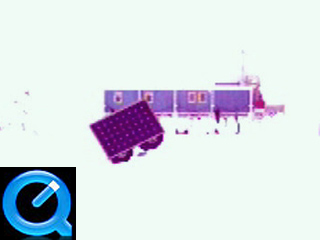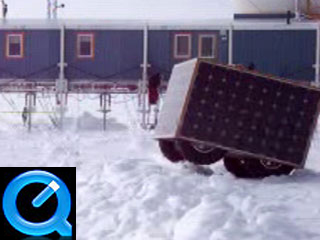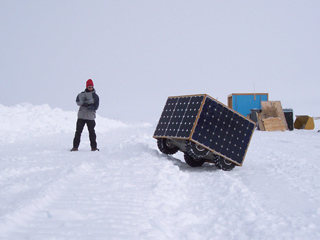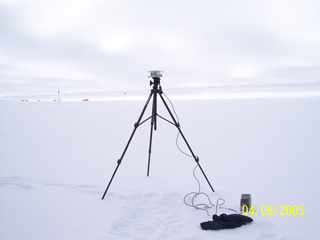
| |<< |< August 4, 2005 >| >>| | |
|
The morning started off well enough. We took the robot over to an area where the a Caterpillar D6 has been driving 8-10 hours a day, moving huge amounts of snow to back fill around and under the raising of the Big House. As a result, there were many hard ridges and trenches for us to drive the robot over. The steepness and height of these features was slightly more than what we can expect to see in Antarctica, but better too hard than too easy. The robot, although looking like it was about to tip over backwards, or do a face-plant here and there, was able to clamber up and over whatever we pointed it at. Check out the pictures down below. And, although it will surely take a good long while to upload, check out the movie clip as well. I apologize for the poor quality - it was taken with a digital camera, not with a proper video camcorder. There is one here at camp, so we will try that out some more tomorrow. Part of the our aim in driving around this morning was to see how the full-sized robot would handle the rough terrain, but also so that we could drain the batteries down from their full charge to something less, so that they could both give and accept energy. I am referring to the fact that we are still working on getting the whole solar power system up and running. Yesterday we succeeded in bringing two panels online, which was almost enough energy to drive in favorable conditions. We wanted at least a third panel. Yesterday we had some hardware problems, which plagued me all the rest of today. I am having some difficulty in conceiving where this latest problem is coming from - there are only so many possible sources, and I think I've eliminated all of them. Yet, there it is all the same - the several small broken parts that I keep having to replaced, without any ultimate success. Jim, meanwhile, was continuing his dogged task of analyzing the data that we are collecting, then going out and collecting more. This afternoon, under the overcast skies that have been our companion nearly our whole time here, Jim collected insolation data using our pyronometer. With this data, we can quantify the amount of sunlight incident on the five panels from various orthogonal orientations. With such cloudy conditions, the amount of sunlight is nearly uniform in all directions. However, if our panels continue to perform well at 18-20% efficiency, then it is easy to envision that we would be able to satisfy our full power budget with the five panels even in these overcast and gloomy conditions. This is an encouraging result, even if we are not currently able to take advantage of it at the moment. --Alex Streeter |
|
 |
 |
| The first of two brief movie clips that show the robot driving over some the terrain we set it to today. Unfortunately, the quality is limited, and the poor camera element was pretty well saturated in this shot. | The second clip, considerably better contrast and quality. |
 |
 |
| A still image from the morning's driving. | Testing with the pyronometer under overcast skies. |
| |<< |< August 4, 2005 >| >>| | |
| [Main] | [Mission] | [Design] | [Science] | [Papers] | [Pictures] | [Team] |
|
Last Updated on 10/20/2005 by Streeter
Site © Thayer School of Engineering, Dartmouth College, Hanover, N.H. |